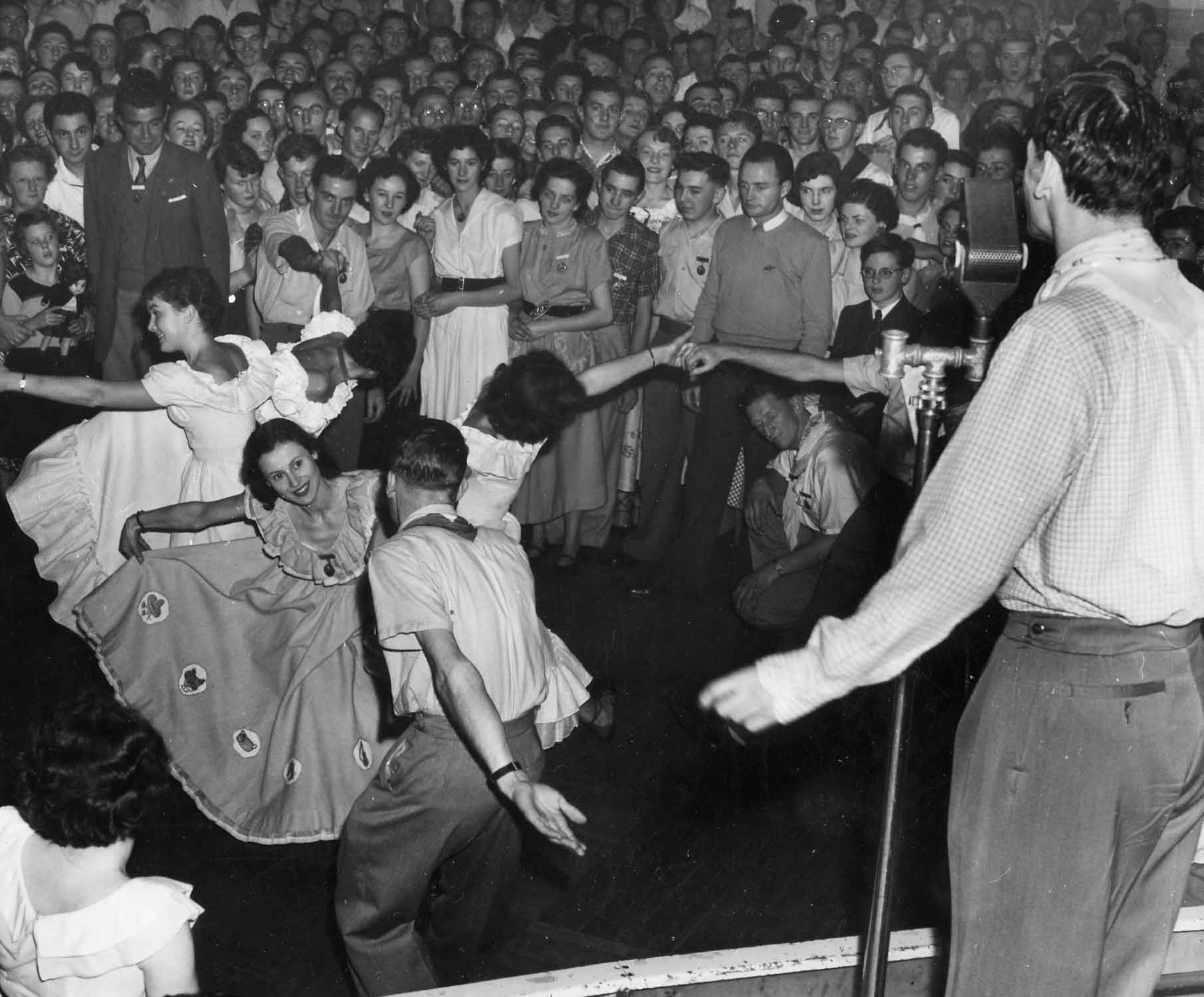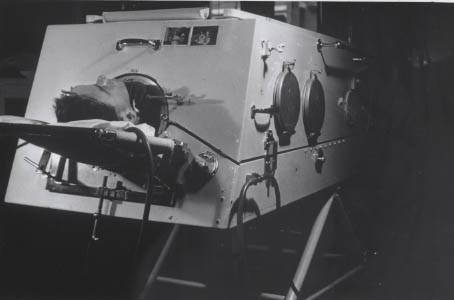


| |
|
Riding a wave of immense public popularity as Australia's premier square dance entertainer, Jim Vickers-Willis made the front page of Melbourne's "The Sun" newspaper when it was announced he was hospitalised with suspected polio (see left). 'The Argus' newspaper (right) also featured Jim, pictured laying in his Fairfield Infectious Diseases Hospital bed, as he is introduced to his new son by his wife Beth. Being a journalist, Jim captured the dramatic moment in his life when he was placed into an iron lung, writing the following article published in both The Argus and The Sun newspapers - just eight weeks after contracting polio: Iron Lung Was Life To Me (May, 1954) "I am lying on my back in a 6-foot box. Every five seconds this box draws a breath for me, then expels it. It has saved my life. Living inside the sealed confines is no discomfort, because outside it I would not live at all. Every time I go outside it, I am gasping for breath and longing to get back inside, where it will push another easy breath of sweet air into my lungs. The box that keeps me alive when, so easily, I could die, is an iron lung. One day, eight weeks ago, I played nine sets of tennis. Now I am lying on my back, my arms and legs are useless, other organs in my body are only working at half speed and the iron lung is breathing for me. This is polio. With the idea of perhaps preventing someone else contracting polio, I want to tell you how I got it. The week before it began to work its way through my system I consulted my Doctor. He told me I was overworking and should take a weeks rest. I also saw a specialist, who said virtually the same thing. The specialist gave me a prescription for a tonic and some tablets to buck me up. I was too busy all the next week to have the prescription made up. I called a square dance for my private square dance club at Prahran Town Hall. When it was done I was very tired and felt pains in my back, around the region of my lungs. I went home, gave them a rub and went to bed….. I awoke with a bad pain in my back, and feeling very sick. I was booked to call at a square dance for my big private club in Adelaide on the Monday night and I immediately planned how this could be cancelled. In the morning, I asked my wife to call the doctor. He came to see me and said he thought I was suffering from nervous exhaustion. Then for a short period, I felt perfectly well. All trace of pain disappeared and I said to my wife: ‘I think I can go to Adelaide after all’. This is one of the features of polio that people should watch – this sudden temporary feeling of fitness that leads to the belief that all is well. The doctor agreed it would probably cause me more worry to cancel the Adelaide show than to fly over, so I decided to go. Immediately I boarded the TAA airliner, I knew I had made a mistake. My back began to ache unmercifully and so did my head. In Adelaide I attended an orchestra rehearsal, called the programme at the club and made a radio broadcast over 5AD…...I was at my last grasp at the end of the programme. The following morning I was in The Advertiser [Adelaide] office typing when I noticed that the little fingers of my right hand would not hit the keys properly. They appeared to be slightly paralysed. This was the first time I thought of polio. Later, I flew back to Melbourne……When I reached home, a young Doctor who had recently worked in a polio ward in Tasmania, looked at me for a few minutes, made me bend forwards and back, examined my arms and legs and said ‘I think you might have polio’.…I was taken to Fairfield Infectious Diseases Hospital as a precaution. From that time, I spent many hours when I did not think I would live – and many more when I particularly didn't’t want to. A wonderful nursing staff and doctors set out to encourage me right from the start, could do little to alleviate the shocking discomfort of those early days and nights of polio. The pain in my back was often relieved by the tablets the nurses gave me. But the discomfort could only be relieved by the personal attention of the nurse as she turned over a pillow, moved a half paralysed arm or leg or turned me from side to side every few moments of the day and night. I was so uncomfortable that all through the day and night, I was constantly ringing the bell for the ward nurse, shouting for her, and taking up an unfair proportion of her time. I kept on asking for a private nurse and this was granted. I then spent two comparatively peaceful nights with this devoted little nurse not only sitting near me, but actually watching my every movement for the entire day and night without a break…….. In the first three days, my right arm became immovable, then my right leg. My left arm became markedly weaker, and my left leg remained the strongest, although it too was severely affected. I had often wondered what it was like to have limbs paralysed. You look at your arm and you say to yourself: ‘I’m going to move that arm’. You try your darndest to move it but it just will not budge. One of the things that shocked me when I came to realise it, was the complete absence of polio treatment. There is no treatment. We all read that this is so, but I rather imagined when I first came to Fairfield that people would be giving me injections of penicillin or something. Of course, that is not so. It shocked me when I discovered they were going to give me absolutely no treatment at all. It was just a matter of lying in bed drinking orange juice and wait for the polio to cease attacking vital nerve centres, paralysing limbs, muscles and organs. About the third day, the doctor appeared to consider the polio was stopping its march through my body. I felt very bad and remember on the second day and third nights, gritting my teeth and saying to myself: ‘ Well, I’ll be fortunate if I see tomorrow’. I now realised that at this stage, I alone didn't’ have the strength to turn the corner unaided. I fell unconscious and was put into an iron lung”. There followed a lot of hazy hours in which I thought someone was trying to strangle me. It was of course the iron lung attachment gripping my neck. I had moments when I was conscious and others when I was hazy. In the clear moments they told me hundreds of square dancers had been ringing the hospital, my home and my mother’s home all day and night. …One square dancer….had arranged for a whole convent to pray for me........Charlie [Jim’s brother] constantly urged me to ‘Keep my chin up, keep on fighting’. He told me everybody else was praying for me and I mustn't let them down. This, and the move into the respirator, had an extraordinary effect, and there is no doubt in my mind now that such encouragement, particularly the knowledge that so many hundreds of square dancers were with me, pulled me around a very tortuous corner. The morning after the move into the respirator, there was no doubt I was getting better. The polio stopped its course. My breathing became much easier. When my family visited me that afternoon they were overjoyed. Both of my arms and both my legs are useless now, but there is some slight sign of movement and physiotherapists are working to get life back into them. To a fellow like me – always a horribly impatient character, always on the go, never still – one of the most difficult tasks has been to readjust myself to just lying around and doing nothing…....Test yourself. Get on a couch, put your hands straight at your sides and your legs straight, and try not to move for two hours. Then realise that a polio patient has to do that all day, day after day. It gets hard, especially when a fly crawls on to your nose. Having got into the iron lung, my next job was to get out. Some remain in it for years. They may get out. They may not. But you can be sure all of them have a high spirit and are fighting to get out. Courage is the one thing that is common to all my fellow-patients here.” ~ Then came Jim’s fight to get free of the iron lung. His fight is described candidly in his autobiography "The Magic of Life". It included a period of recuperation in Queensland, bathing in the warmer waters - not dissimilar to the method adopted by Franklin D. Roosevelt, who used warm water therapy at the 'Warm Springs' resort (which he had created and made famous) after he contracted polio and became paralysed in 1921, before going on to become the 32nd President of the United States (1933-1945) - yet another inspiring story of a survivor. |
 The Argus August 17, 1954
PolioNetwork
|
All materials on this site are Copyright©Vickers-Willis Corporation, 2023